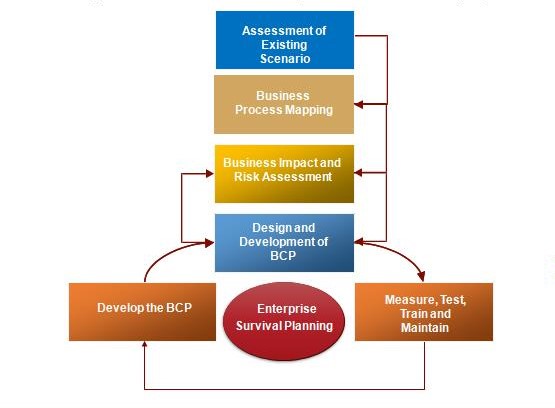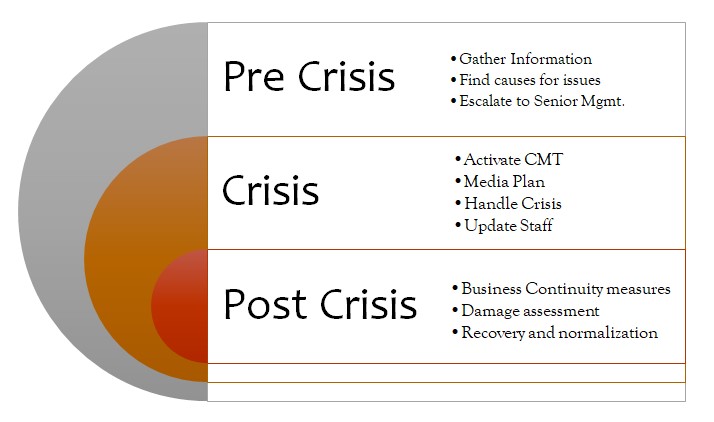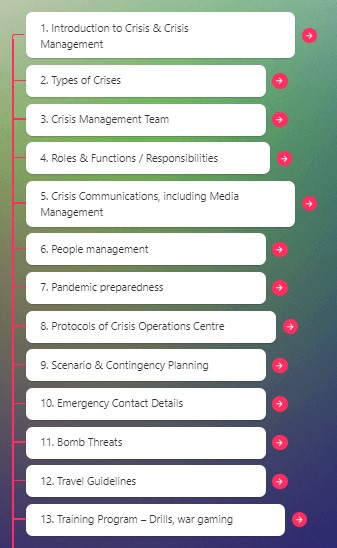Organizational Resilience is one of the main ingredients ensuring organizational longevity. It refers to the ability of the organization to foresee , re-align, respond and adapt to major changes for survival and prosperity . We help organizations to prepare themselves to mitigate the risk of operational melt down and not being able continue the delivery of products or services at pre-defined acceptable levels following a disruptive incident
Business Continuity Planning
Each and every business works in an independent environment and thus factors affecting the business may vary for even the same sectors and same type of business. So we tend to customize the process based on our specific client.. This involves a combination of understanding their specific needs, providing expertise, and collaborating with key stakeholders. Here are some general steps we take to assist organizations in their BCP efforts:
- Understand the Business
- Risk Assessment
- Review and Update
- Develop a BCP Framework
- Develop and Test Plans
- Training and Awareness
- Business Impact Analysis
- Collaborate with Stakeholders
- Technology and Infrastructure
- Compliance and Regulations

Collaborate with Stakeholders
• Work closely with key stakeholders, both internal and external, to ensure a coordinated response to disruptions.
• Establish communication protocols for sharing information during a crisis.
Develop and Test Plans
• Collaborate with the organization to develop detailed BCPs for critical functions, including strategies for continuity and recovery.
• Conduct regular drills and exercises to test the effectiveness of the plans and identify areas for improvement.
Training and Awareness
• Provide training to employees on their roles and responsibilities during a crisis.
• Raise awareness about the importance of business continuity throughout the organization.
Review and Update
• Regularly review and update the BCP to reflect changes in the organization's structure, processes, or external environment.
• Stay informed about emerging risks and adapt the plan accordingly.
Compliance and Regulations
• Ensure that the BCP aligns with industry regulations and compliance requirements.
• Stay informed about changes in regulations that may impact business continuity planning.
We have helped organizations in various sectors with their BCP to help them align for a longer duration.
Environmental , Social Governance
Investors and other stakeholders, including socially responsible investors, are increasingly incorporating ESG criteria into their decision-making processes. They believe that a focus on sustainability and ethical practices can contribute to long-term financial performance and reduce risks associated with environmental, social, and governance issues.
Companies that prioritize ESG considerations often report on their performance in these areas through sustainability reports, and some stock exchanges require listed companies to disclose relevant ESG information.
Environmental, Social, and Governance, and it refers to a set of criteria used to evaluate a company's performance in these three areas. Investors and other stakeholders use ESG factors to assess the sustainability and ethical impact of a business. Here's a brief overview of each component of ESG:
Crisis Management
Ability of a n organization to bounce back In the event of a crisis , like the recent Carona virus fiasco and able to continue its operations ensures its resilience . We help entities to be ready for such scenarios
When a larger emergency happens that affects the entire organization, the emergency would become a crisis. There are a number of crises that can occur, some of which are listed below:
- Security, including acts of terrorism
- Safety, including health or medical
- Natural Disasters
- Legal Crises - may result out of damaging lawsuits
- Reputation Crises – social media risks, negative customer remarks
- Product Crisis – e.g. contamination, leakage in tea bags, etc.
- Environmental disasters
- Internal threats – sabotage, theft, embezzlement, etc.
- People Crisis – e.g. kidnap, loss of personnel, etc.
- Pandemics – like the current COVID-19 crisis
- Supply Chain disruptions
- Civil riots
- Political
- Economic
And many others. It is essential that organizations develop the capability to handle all types of crises. IRTIKAZ solutions’ team consists of the top Crisis Management professionals in the Asia Pacific region with many years of handling real life crises for some of the largest companies in the world.
Broadly speaking, below are the stages of a Crisis and measures to think about or take. It is important to remember that all Crises are different and may need different measures. However, there are some common steps to take.


It is essential that organizations develop the capability to handle all types of crises. IRTIKAZ solutions’ team consists of the top Crisis Management professionals in the Asia Pacific region with many years of handling real life crises for some of the largest companies in the world.
Broadly speaking, here are the stages of a Crisis and measures on the left side to think about or take. It is important to remember that all Crises are different and may need different measures. However, there are some common steps to take.
Our Crisis Management Plan will generally be mapped as shown in the figure.
We help entities to be up and running very quickly in such scenarios ensuring minimum down time. Crisis Management leads to BCP.
Health , Safety & Environment ( HSE )
In the HSE ambit we offer expertise, guidance, and practical solutions to help businesses comply with regulations, improve safety practices, and promote environmental sustainability. Here are some key aspects of what we offer :
Connect with our Organizational Resilience Practice
Connect for expert solutions in strengthening your business against disruptions and ensuring long-term adaptability and success.

